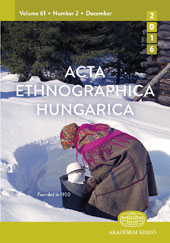DYNAMIK, GEOGRAPHIE UND GESELLSCHAFTSSPEZIFIK DER JÜDISCHEN ANSIEDLUNG IN PEST UM DIE MITTE DES 19. JAHRHUNDERTS
THE DYNAMICS, GEOGRAPHICAL AND SOCIAL CHARACTERISTICS OF THE SETTLEMENT OF JEWS IN PEST IN THE MID-19TH CENTURY
Author(s): Larissa HROTKÓSubject(s): Cultural history, Regional Geography, Social history, History of Judaism, Culture and social structure , 19th Century
Published by: Akadémiai Kiadó
Keywords: toleranz; commorans Jews; social structure of single mothers and children born out of wedlock; behaviour of religious community; kehila (the Jewish religious community); mohel (circumciser);
Summary/Abstract: The author examines the life and internal social problems of the Jews settled in Pest towards the end of the 18th century. Even before that time Jewish society was not homogeneous, and this was also the case in Pest. The social differences can be seen in the dynamics and geography of the settlement. The first to arrive in Pest were entrepreneurs from Óbuda who had considerable influence in the region, followed by wholesale merchants from Pozsony. The more prosperous entrepreneurs and wholesalers attracted the poorer Jewish strata who did not have the permanent Pest residence permits required for independent business activity (the so-called Toleranz). Although the great majority of the Jews lived in Terézváros (Theresa Town), where individual families lived depended on their financial situation. The more prosperous the new settlers were, the further they lived from the old centre of Terézváros, the core of which was formed by the area around Dob and Király streets. However, it was here that the first synagogues were opened. The denominational records of births and deaths that formed part of the research material show that in the new Pest Jewish society there were also family forms differing from the religious norm. The question arises of how the Jewish community accepted the unmarried mothers and children born out of wedlock. There is proof that the single mothers also had their sons circumcised and all deceased Jewish children were probably buried in the Israelite cemetery. These facts point to acceptance, but the way the entries were made in the records of births and deaths indicates that the community acknowledged only reluctantly the structure of births outside wedlock.
Journal: Acta Ethnographica Hungarica
- Issue Year: 53/2008
- Issue No: 2
- Page Range: 263-276
- Page Count: 14
- Language: German
- Content File-PDF

